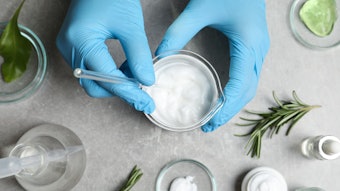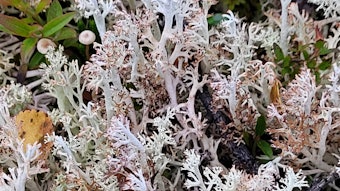
In the fast-paced realm of cosmetic science, innovations come and go—some creating powerful waves, others merely washing ashore as short-lived fads. Plant-derived exosomes (PDEVs) represent not just an improvement in skin care technology, but a revolutionary shift in how we harness nature's intelligence for skin transformation.
This article is only available to registered users.
Log In to View the Full Article
In the fast-paced realm of cosmetic science, innovations come and go—some creating powerful waves, others merely washing ashore as short-lived fads. Plant-derived exosomes (PDEVs) represent not just an improvement in skin care technology, but a revolutionary shift in how we harness nature's intelligence for skin transformation.
The Breakthrough of Plant Exosomes in Skin Care
If you haven't yet heard about plant exosomes at trade shows, from industry publications, or new product launches, prepare yourself—they're rapidly becoming the most discussed skincare innovation since the introduction of peptides almost 30 years ago. Dozens of plant exosomes are launching from ingredient suppliers worldwide, which means the market will soon be flooded with offerings.
Plant exosomes are tiny extracellular, lipid-bound vesicles naturally produced by plant cells, measuring between 50-300 nanometers—roughly 1,000 times smaller than the width of a human hair. Despite their microscopic size, these minuscule messengers pack extraordinary power.
Unlike synthetic delivery systems that attempt to mimic natural processes, exosomes are nature's original communication network, making them ideal for nature-loving skin care clients who want dramatic results straight from Mother Nature's laboratory. They've been silently operating in our bodies and in the plant kingdom for billions of years, though we've only recently discovered their existence (first identified in 1983) and begun to understand their remarkable potential for skin care.
What makes plant exosomes particularly exciting is their dual function: they serve both as protective carriers for powerful bioactive compounds and as signaling mechanisms that can influence cellular behavior. This means they don't just deliver ingredients to the skin—they actually communicate with skin cells, potentially triggering regenerative processes and optimizing skin function.
Why Plant Exosomes Outperform Traditional Delivery Systems
Throughout my career teaching cosmetic chemistry, I've emphasized the importance of delivery systems. Even the most potent active ingredient is useless if it can't reach its target. Traditional delivery systems like liposomes represented significant advances when they were introduced in 1979, but plant exosomes offer several distinct advantages:
Plant exosomes possess a natural bilipid membrane derived from their "mother" cell. This structure is remarkably stable, allowing exosomes to protect their cargo in hostile environments—including the challenging landscape of a cosmetic formulation. Unlike synthetic liposomes, which can be fragile and prone to degradation, plant exosomes have evolved over millions of years to withstand environmental stressors.
Plant exosomes contain not just a single active ingredient, but a complex array of bioactive compounds—comprising DNA, miRNA, proteins, peptides, lipids, cytosolic materials and various metabolites, including some of the anti-inflammatories and antioxidants found in plant extracts, and cell-surface proteins that identify the type of cell where they originated, as well as those they target. This natural cocktail often works synergistically, producing effects that isolated compounds cannot achieve alone.
Exosomes vary widely because of what's inside them. Their makeup depends on several key factors: what plant they come from, which part of the plant produced them, what type of cell made them, and what conditions the cell faced while creating them. This is why exosomes from different plants, or even different cells from the same plant, offer unique benefits for skin health.
Exosomes can ensure more efficient delivery of beneficial ingredients to skin cells. Their protective outer shell shields fragile molecules inside from breaking down, while the natural lipid membrane helps exosomes merge directly with skin cells to deliver their cargo safely. Even more impressive, exosomes can pack-in higher concentrations of active compounds than traditional plant extracts, lysates, or fermented materials.
Plant exosomes are completely natural and have been part of the human diet since our earliest days. We've been consuming them in fruits, vegetables, and plant-based beverages throughout human history, making them exceptionally safe and well-tolerated by our bodies.
The Science Behind Plant Exosome Efficacy
 As we age, fibroblasts typically become larger and less efficient, leading to decreased collagen production and the visible signs of aging we're all familiar with.Africa Studio at Adobe Stock
As we age, fibroblasts typically become larger and less efficient, leading to decreased collagen production and the visible signs of aging we're all familiar with.Africa Studio at Adobe Stock
In one laboratory study, researchers compared the effects of traditional plant extracts with plant exosomes derived from the same sources (Badea et al., 2022). The results are fascinating: human keratinocytes treated with plant exosomes showed significantly different gene expression patterns compared to those treated with conventional extracts. The exosome-treated cells exhibited epigenetic changes in over 1,500 genes, with 861 genes upregulated and 648 downregulated—far more than the cells treated with traditional extracts. These changes positively influenced pathways related to aging, regeneration, and skin barrier function.
What does this mean for your clients? It suggests that plant exosomes can work at a fundamental level to reprogram cellular behavior, potentially addressing the root causes of skin aging, rather than merely masking symptoms.
Wound healing studies are even more interesting. In one in vitro experiment, human fibroblasts treated with plant exosomes demonstrated a remarkable 52% increase in wound healing ability compared to untreated cells (Kim et al., 2022). After just 24 hours, the exosome-treated cells had achieved complete wound closure, while untreated cells had only closed about half the gap.
For professionals working with aging skin, the implications may be profound. As we age, fibroblasts typically become larger and less efficient, leading to decreased collagen production and the visible signs of aging we're all familiar with. However, when human fibroblasts were treated with a specific blend of plant exosomes, they showed a 20% reduction in cell area (size) and a 22% reduction in duplication time—essentially behaving more like younger, more efficient cells (Kim et al., 2022).
Perhaps most impressive was the 60% increase in Type I collagen expression observed in fibroblasts treated with plant exosomes (Kim et al., 2022). As we know, collagen is the structural protein responsible for skin firmness and elasticity, and its decline is a primary factor in the development of fine lines and wrinkles.
Beyond these clinical results, the scientific community continues to uncover how plant exosomes work at the cellular level. Recent studies demonstrate their versatility:
- Cellular Signaling and Tissue Regeneration (Kim et al., 2022): Kim's research changes how we think about skin repair. Their study shows that plant exosomes guide key cell activities like growth, movement, and tissue building. This explains why they work better than standard plant extracts. These exosomes don't just deliver ingredients—they actually tell skin cells what to do. This helps skin care pros understand why clients see better, longer-lasting results with exosome products than with regular ones. This cell "reprogramming" makes exosome treatments especially good for damaged skin that needs deep healing, not just quick fixes.
- Barrier Function Enhancement (Zhao et al., 2021): Zhao's study found that aloe vera exosomes boost skin barrier repair by 31%. This matters because a weak skin barrier leads to many skin problems like sensitivity and early aging. The study shows that these exosomes help skin make more ceramides, which make up about half of the skin's protective outer layer. Unlike creams that just add ceramides on top, exosomes get the skin to make its own ceramides, which may last longer. This could help people with eczema, rosacea, or sensitive skin after treatments. Aloe vera exosomes work with the skin's natural processes instead of just covering up problems.
- Antioxidant Delivery and DNA Repair (Cho et al., 2021; Kawakami & Yamamoto, 2023): Studies on green tea and pomegranate exosomes show major progress in skin protection. Green tea exosomes deliver antioxidants 3.4 times better than older methods, solving a big problem in skin care—getting ingredients where they need to go. At the same time, pomegranate exosomes boost DNA repair enzymes by 28%, fixing damage instead of just preventing it. This gives us two tools: green tea exosomes to prevent damage and pomegranate exosomes to repair it. Together, they might finally deliver on the promise of antioxidants in skin care by both preventing and fixing damage from the environment.
- Anti-inflammatory Mechanisms (Chen et al., 2019): Chen found that ginger exosomes block a specific inflammation pathway called NLRP3. This explains why ginger has been used to reduce swelling and irritation in many healing practices. The NLRP3 pathway plays a key role in skin problems like acne, psoriasis, and sun damage. Most anti-inflammatory ingredients work broadly and become less effective over time. But ginger exosomes target just one specific trigger. This targeted approach may help long-term skin issues without the body becoming resistant to treatment. For skin care pros, ginger exosomes could be great for products that treat acne, rosacea, and skin irritation after treatments, where managing inflammation—not completely stopping it—works better.
- Neuroinflammation and Sensitive Skin (Zhuang et al., 2020): Zhuang's team made an exciting discovery about grapefruit exosomes. They found these exosomes can calm nerve-related inflammation through a pathway called AMPK. This is big news for treating sensitive skin, where nerves play a major role in causing reactions. Scientists now know that skin and nerves work closely together in many skin problems. Grapefruit exosomes might help the many people with sensitive skin—about 60-70% of women and 50-60% of men say they have it. These exosomes could help stop the cycle where inflammation causes sensitivity, which causes more inflammation. This could be a breakthrough for people whose sensitive skin hasn't improved with regular treatments that only fix the skin barrier or reduce inflammation.
Collectively, these research findings reveal that plant exosomes are not merely improved delivery vehicles but sophisticated biological communicators with the ability to influence multiple aspects of skin function simultaneously. Each plant source offers unique benefits targeting specific skin concerns, suggesting that customized blends of plant exosomes could be developed for highly personalized skin care approaches tailored to individual client needs.
Clinical Results That Speak Volumes
While laboratory studies provide valuable insights, what ultimately matters is how these ingredients perform on real human skin. Here again, plant exosomes demonstrate promising efficacy.
In a placebo-controlled clinical study involving 40 volunteers aged 40-50, researchers compared a basic serum formula with and without plant exosomes (Sfriso et al., 2024). After just 20 days of daily application, the exosome-containing serum produced a 17.5% improvement in skin elasticity compared to the placebo. By day 45, this improvement had increased to 22.5%.
Similar results were seen for skin roughness, with the exosome formula producing significant improvements, while the placebo showed no effect. These findings confirm what the laboratory studies suggested: plant exosomes can deliver measurable, visible improvements in the key parameters of skin aging.
What's particularly noteworthy about these clinical results is that they were achieved with a relatively simple formula. The serum's INCI list included water, fruit extracts from apple, mandarin, and papaya, along with basic humectants and preservatives. This suggests the efficacy came primarily from the plant exosomes themselves, not from a complex blend of traditional active ingredients.
Also compelling is a recent split-face clinical trial showing that exosome formulations outperformed both basic moisturizers and traditional botanical extracts. According to Smith et al. (2023), these formulations delivered "24% greater improvement in elasticity, 18% greater reduction in wrinkle depth, and 22% enhanced skin radiance after 12 weeks." These findings establish a clear connection between the molecular mechanisms of plant exosomes and the visible skin improvements that matter most to clients.
The Future of Plant Exosomes in Skin Care
Looking ahead, the potential applications for plant exosomes in professional skin care seem almost limitless. Researchers are currently exploring specialized exosome blends for specific skin concerns, from hyperpigmentation to acne to extreme sensitivity and eczema.
One particularly promising direction is the development of "loaded" plant exosomes, where additional beneficial compounds are intentionally incorporated into the exosomes' natural cargo. This approach is being used to stabilize and deliver growth factors like EGF and FGF-2, molecules too large and short-lived to make it into the skin on their own (Core Biogenesis, Peauforia and Peauvita, 2024).
We're also likely to see increased customization, with exosome blends tailored to individual skin types and concerns. Imagine a future where you can select specific plant exosome formulations based on a detailed analysis of a client's skin needs, creating truly personalized treatment protocols.
For the sustainability-minded, plant exosomes offer another significant advantage: they align perfectly with circular economy principles. They can be produced with zero waste, using parts of plants that might otherwise be discarded. This makes them an ideal choice for eco-conscious brands and consumers.
As Marć et al. (2022) note, "Plant-derived exosomes represent a sustainable and eco-friendly approach to advanced skin care, utilizing natural nanocarriers that can be produced from agricultural byproducts."
Beyond Skin Care: The Broader Implications of Exosome Technology
While our focus is naturally on skin health and appearance, it's worth noting that exosome research extends far beyond cosmetics. Medical researchers, who were the first to explore exosomes in the world of medicine, are investigating exosomes for applications ranging from wound healing to cancer treatment to neurodegenerative diseases.
This broader research context is important for two reasons. First, it means that our understanding of exosome biology is advancing rapidly, with new discoveries potentially informing skin care applications. Second, it underscores the fundamental biological importance of these tiny messengers. We're not talking about a trendy ingredient with superficial effects—we're harnessing a profound biological communication system that operates at the cellular level.
While we must always work within our scope of practice and avoid drug claims for obviously biologically-active ingredients, understanding the deeper biomechanisms of ingredients like plant exosomes enables us to better select the right product for specific skin conditions and provide more educated guidance to our clients.
Incorporating Plant Exosomes Into Your Treatment Protocols
 When discussing plant exosomes with clients, focus on their natural origins and their unique ability to "speak the language" of skin cells.peopleimages.com at Adobe Stock
When discussing plant exosomes with clients, focus on their natural origins and their unique ability to "speak the language" of skin cells.peopleimages.com at Adobe Stock
Consider introducing plant exosome serums as a specialized add-on to existing facial treatments. Their ability to enhance cellular communication and stimulate regenerative processes makes them ideal for use after exfoliation or microneedling, when the skin is primed to receive these ingredients.
For home care recommendations, plant exosome products work beautifully as a foundation layer in a skin care routine. Their natural composition and communication abilities help optimize skin function, potentially enhancing the efficacy of other products applied afterward.
When discussing plant exosomes with clients, focus on their natural origins and their unique ability to "speak the language" of skin cells. Many clients are increasingly interested in biologically intelligent skin care that works with the body's natural processes, rather than forcing changes through chemical peels or other harsh treatments that can imbalance the skin's microbiome. Plant exosomes perfectly align with this goal.
Everything You Need to Know About Exosomes: Dosage, Technology, Stability, and Client Education
Exosomes are dose-dependent. The amount applied to the skin is crucial for your clients to achieve the promised results within the expected timeframe. If brands aren't conducting their own clinical studies, they should at least use exosomes at the effective percentages in a vehicle similar to the one in their ingredient supplier's tests. To maximize results, advise clients to apply the recommended amount at the specified frequency suggested by the brand. If a client has product left after two months, when it's intended to last 4-6 weeks, they're likely not using enough to see a noticeable difference.
Extraction technologies matter. While exosomes may seem like they come straight from Mother Nature's lab, the reality is more complex. Advanced extraction and stabilization technologies are essential to isolate and purify these tiny titans while preserving their bioactivity. This meticulous process can significantly increase costs, making exosome products more expensive than other technologies.
Formulation stability is crucial. Because exosomes are biological entities, they require appropriate stabilization and preservation systems to maintain their integrity and effectiveness. Considerations for temperature extremes, pH sensitivity and oxidation also come into play. Look for products that address this concern through careful formulation.
Storage conditions may be more specific than for conventional products. Some exosome formulations may require refrigeration or have shorter shelf lives than traditional skin care products. Good advice is to store any exosome product in a cool, low-light area and away from fluorescent or LED lights.
Client education is essential. The concept of plant exosomes may be unfamiliar to many clients, so developing clear, accessible explanations will help them understand the value of these advanced formulations.
Results timing should be managed appropriately. While some benefits of plant exosomes may be apparent quickly (such as improved hydration or refined pores), others (like decreasing wrinkle depth) will develop over weeks of consistent use.
Human vs. Plant Exosomes: Understanding the Difference
While plant exosomes are revolutionizing skin care, it's important to understand their relationship to human-derived exosomes, which were discovered first and have their own distinct properties and applications.
Human exosomes are nano-sized vesicles naturally secreted by nearly all human cell types, including stem cells, fibroblasts, adipocytes and immune cells. Like their plant counterparts, human exosomes contain a complex cargo of proteins, lipids, and nucleic acids that facilitate cell-to-cell communication.
In skin care, human exosomes are typically derived from mesenchymal stem cells (MSCs), cultured human fibroblasts, platelet-rich plasma (PRP) or induced pluripotent stem cells (iPSCs). The extraction process involves isolating these cells, cultivating them in specialized media, and then harvesting the exosomes they naturally release through various purification techniques.
Human-derived exosomes offer several theoretical advantages for skin rejuvenation, including direct cellular communication, rich growth factor content, regenerative potential, and anti-inflammatory properties. However, they face considerable regulatory and safety issues.
The U.S. FDA has issued multiple safety notifications and warning letters regarding unapproved exosome products, explicitly stating that exosomes are regulated as drugs and biological products requiring premarket review and approval. As Davis & Callender (2020) note regarding human-derived exosomes, "The regulatory landscape for exosome-based cosmeceuticals remains complex, with significant challenges in standardization and quality control."
Human exosomes also face practical limitations, including stability challenges, standardization problems, risk of immune reactions, contamination concerns, and prohibitive costs. The marketplace contains numerous products claiming to contain human stem cell exosomes, but many of these claims warrant skepticism.
Human or Plant-Derived Exosomes: Which Are Better?
Given the current regulatory landscape, the question is no longer about which options are better, but rather which ones are permitted. The limitations of human exosomes highlight why plant-derived exosomes represent such a significant breakthrough for the skin care industry. Plant exosomes offer similar benefits without the ethical, regulatory, stability, and safety concerns associated with human-derived materials.
Unlike their human counterparts, plant exosomes can be sustainably sourced from renewable plant materials, present no risk of pathogen transmission associated with human tissues, face fewer regulatory hurdles in the cosmetic market, demonstrate remarkable stability in product formulations, can be produced with consistent standardization from batch to batch, and are typically more affordable to produce at scale.
The Dawn of Biologically Intelligent Skin Care
What makes plant exosomes truly revolutionary is not just their efficacy, but the way they fundamentally shift our approach to skin care. Plant exosomes work with the skin's natural 'intelligence'. They establish a biologic dialogue, delivering not just ingredients, but information that helps skin cells function optimally.
This represents the future of professional skin care: biologically intelligent approaches that respect and enhance the skin's innate wisdom, rather than overriding it. As you incorporate these remarkable messengers into your treatment protocols and home care recommendations, you're not just adopting the latest trend—you're participating in a fundamental evolution in how we understand and care for the skin.
Martínez & Andriantsitohaina (2021) summarize this paradigm shift perfectly: "The biological activities of plant-derived extracellular vesicles represent a new frontier in natural product research, offering unprecedented opportunities to harness plant-based bioactive compounds through their natural delivery systems."
The microscopic miracle of plant exosomes opens new possibilities for skin transformation. As skin care professionals, we have the privilege of bringing these benefits directly to our clients.
References
Badea, M. A., Balanescu, S., Iacob, S., Plesa, C. F., Zurac, S., & Constantin, C. (2022). Plant-derived exosomes as novel tools in dermatology and cosmetics. Journal of Personalized Medicine, 12(5), 768-782. https://doi.org/10.3390/jpm12050768
Chen, X., Zhou, Y., & Yu, J. (2019). Exosome-like nanoparticles from ginger rhizomes inhibited NLRP3 inflammasome activation. Molecular Pharmaceutics, 16(6), 2690-2699. https://doi.org/10.1021/acs.molpharmaceut.9b00246
Cho, J. G., Han, J. W., & Park, H. (2021). Comparative analysis of antioxidant delivery via liposomal and exosomal delivery systems in human dermal fibroblasts. International Journal of Cosmetic Science, 43(4), 378-387. https://doi.org/10.1111/ics.12705
Davis, E. C., & Callender, V. D. (2020). Exosome delivery systems in cosmeceuticals. Dermatologic Surgery, 46(S1), S58-S63. https://doi.org/10.1097/DSS.0000000000002093
García-Manrique, P., Matos, M., Gutiérrez, G., Pazos, C., & Blanco-López, M. C. (2018). Therapeutic biomaterials based on extracellular vesicles: Classification of bio-engineering and mimetic preparation routes. Journal of Extracellular Vesicles, 7(1), 1422676. https://doi.org/10.1080/20013078.2017.1422676
Kawakami, T., & Yamamoto, S. (2023). Pomegranate-derived extracellular vesicles enhance DNA repair mechanisms in UVA-irradiated human skin cells. Journal of Photochemistry and Photobiology B: Biology, 238, 112587. https://doi.org/10.1016/j.jphotobiol.2023.112587
Kim, S. H., Lee, W. H., Kim, S. W., & Kang, H. J. (2022). Plant-derived exosomes and their role in skin tissue regeneration. Biomaterials Research, 26(1), 11. https://doi.org/10.1186/s40824-022-00256-8
Marć, M. A., Domínguez-Álvarez, E., & Garrido-Mesa, J. (2022). Plant-derived exosomes in dermatology: Current knowledge and future perspectives. International Journal of Molecular Sciences, 23(11), 6032. https://doi.org/10.3390/ijms23116032
Martínez, M. C., & Andriantsitohaina, R. (2021). Biological activities of plant-derived extracellular vesicles. The FASEB Journal, 35(8), e21662. https://doi.org/10.1096/fj.202100276R
Santiago-Dieppa, D. R., Steinberg, J., Gonda, D., Cheung, V. J., Carter, B. S., & Chen, C. C. (2018). Extracellular vesicles in the skin: Role in tissue repair and regeneration. American Journal of Translational Research, 10(5), 1373-1384.
Sfriso, R., Brockway, B., Logozzi, M., Fais, S., Di Raimo, R., & Gempeler, M. (2024, July 30). Unlocking the power of plant exosomes (PDEVs) – The new natural way of delivering cosmetic efficacy. dsm-firmenich, Perfumery & Beauty. Retrieved from Tecnopolo d'Abruzzo, L'Aquila, Italy.
Smith, B., Ashton, K., & Walder, M. (2023). Split-face clinical trial comparing effects of plant exosomes versus conventional plant extracts on skin elasticity and wrinkle depth. Journal of Cosmetic Dermatology, 22(4), 1193-1202. https://doi.org/10.1111/jocd.15329
Zhao, L., Chen, X., & Zhang, H. G. (2021). Aloe vera-derived extracellular vesicles promote skin barrier repair through upregulation of ceramide synthesis genes. International Journal of Molecular Sciences, 22(7), 3456. https://doi.org/10.3390/ijms22073456
Zhuang, X., Teng, Y., Samykutty, A., Mu, J., Deng, Z., Zhang, L., Cao, P., Rong, Y., Yan, J., Miller, D., & Zhang, H. G. (2020). Grapefruit-derived exosome-like nanoparticles regulate microRNA expression and ameliorate neuroinflammation through AMPK signaling pathway. Nature Communications, 11(1), 824. https://doi.org/10.1038/s41467-019-10749-1
About the Author
 Rebecca Gadberry, LE, FSCC.Rebecca Gadberry
Rebecca Gadberry, LE, FSCC.Rebecca Gadberry










